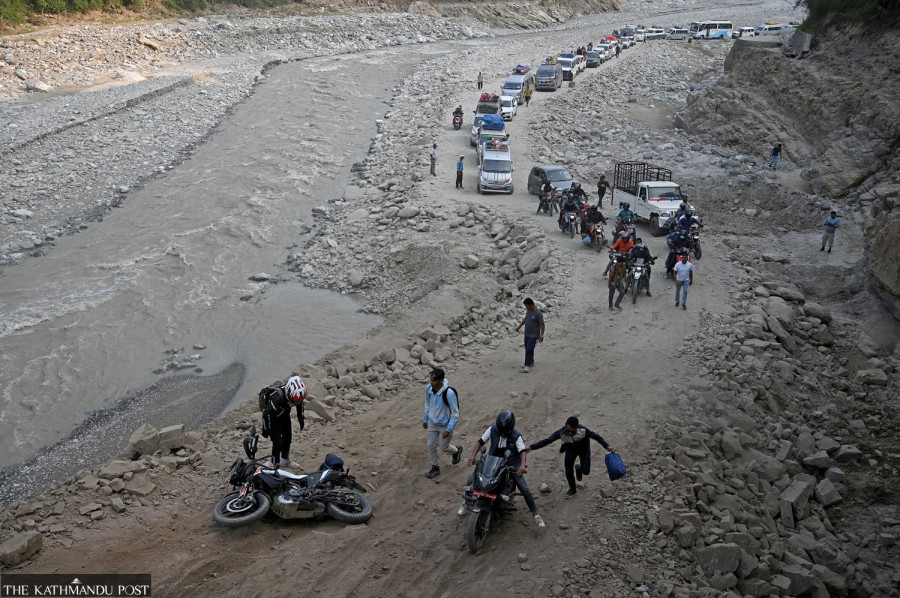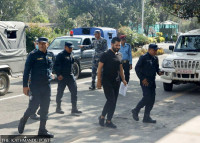National
Flood-hit local units warily hope vital services will be fixed by Oli’s deadline
Local representatives say the federal government failed to provide help when villages were devastated by floods.
Post Report
At the 14th meeting of the National Disaster Risk Reduction and Management Authority held at the PM’s Office on Friday, Prime Minister KP Sharma Oli directed relevant agencies and the three levels of government—federal, provincial and local—to expedite relief distribution and reconstruction efforts.
Oli instructed the officials present to expedite the works of relief distribution and reconstruction of infrastructure damaged by the devastating floods and landslides triggered by heavy rainfall from September 26 to 28 in the central and eastern parts of Nepal.
The prime minister gave a timeline to accomplish specific tasks. For instance, he asked the authorities to restore disrupted basic services such as electricity, health facilities, and drinking water within 15 days.
He directed the agencies to disburse funds needed to prepare temporary housing for the displaced communities by mid-November.
The government, through the Cabinet decision of October 4, declared the 71 local units of 20 districts ‘disaster crisis zones’ for three months. Thereafter, the government shifted its focus on relief distribution.
Under the Disaster Risk Reduction and Management Act 2017, the government can announce a disaster crisis area to respond to a calamity by specifying its boundaries and a time limit.
In crisis-designated areas, the government can make decisions such as prohibiting any operation that may adversely affect rescue work, employing government or non-government sector employees, and using government, non-government, or private movable and immovable property as needed for disaster rescue work, as per the Act. Also, the authorities can fast-track the procurement process for the purpose of expediting services in the crisis-hit areas in the given time.
But are the decisions made on Friday by the NDRRMA, the agency that responds to disasters, and the decision made by the Cabinet on October 4, in tandem? Government officials say the two are distinct, although both are meant to address the crisis created by heavy rains.
“Declaring the disaster crisis zones and ensuring serious engagement in relief distribution and reconstruction are two different things,” Dil Kumar Tamang, information officer for the home ministry, told the Post. “The disaster crisis zones addressed people’s short-term needs, while Friday's decision is related to longer-term works.”
On Friday, Prime Minister Oli also compared the crisis caused by the recent floods and landslides to the aftermath of the devastating earthquakes of 2015.
Prime Minister Oli directed the authorities to promptly conduct a post-disaster needs assessment, and to organise a conference by inviting representatives of donor agencies and foreign governments to secure funds needed for the reconstruction and rehabilitation in the disaster-hit settlements.
“Our focus should be on quickly providing relief and housing to the affected people,” Prime Minister Oli was quoted as saying at the meeting.
Despite the prime minister’s claim of expediting reconstruction work, some local representatives the Post spoke to raised questions about the federal government’s handling of the disaster.
Dinesh Lama, chairperson of Roshi Rural Municipality, was one of them. He says the federal government was unable to provide help when entire settlements were swept by landslides in Roshi.
Representatives from many of the 71 local units designated ‘disaster crisis zones’ said they haven’t received the monetary help announced by the federal government.

Deepa Bohara, chairperson of Sunkoshi Rural Municipality in Sindhuli district, said her local unit had not received any help from Kathmandu.
“Our municipality suffered more infrastructure damage than human loss, but we have yet to get the Rs200,000 compensation announced by the government for the families affected by the disaster,” Bohara told the Post. “We are supposed to get it through the District Administration Office, but we are still waiting.”
The representatives of local units also urged the federal government to relocate those rendered homeless to a safer place and to build shelters for them immediately.
On essential services including electricity, officials at the Ministry of Energy, Water Resources, and Irrigation expressed hope that they would be able to restore the disrupted services within the stipulated time.
“In the past, those in Kathmandu used to give directions without properly understanding the ground reality. We hope that practice won’t be repeated this time around,” officials told the Post on the condition of anonymity.
The Friday meeting of the NDRRMA decided that the federal, provincial and local governments must conduct a post-disaster assessment before undertaking reconstruction and rehabilitation works.
At least 250 people lost their lives in the past month in floods and landslides triggered by heavy rains lasting days, according to the Nepal Police.
As per the Department of Hydrology and Metrology, the rainfall Nepal witnessed in the last week of September was the highest at least in 54 years. Nepal started recording rainfall data 54 years ago.
The preliminary study of the government claims that the rainfall has caused cumulative loss of around Rs46 billion.




 8.12°C Kathmandu
8.12°C Kathmandu














